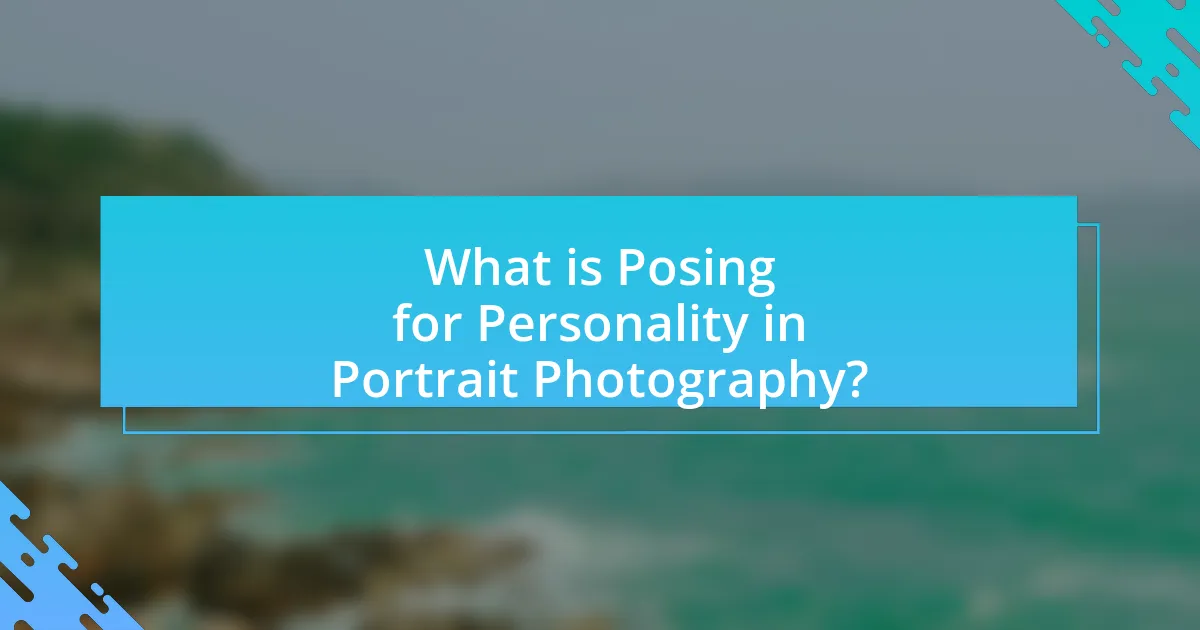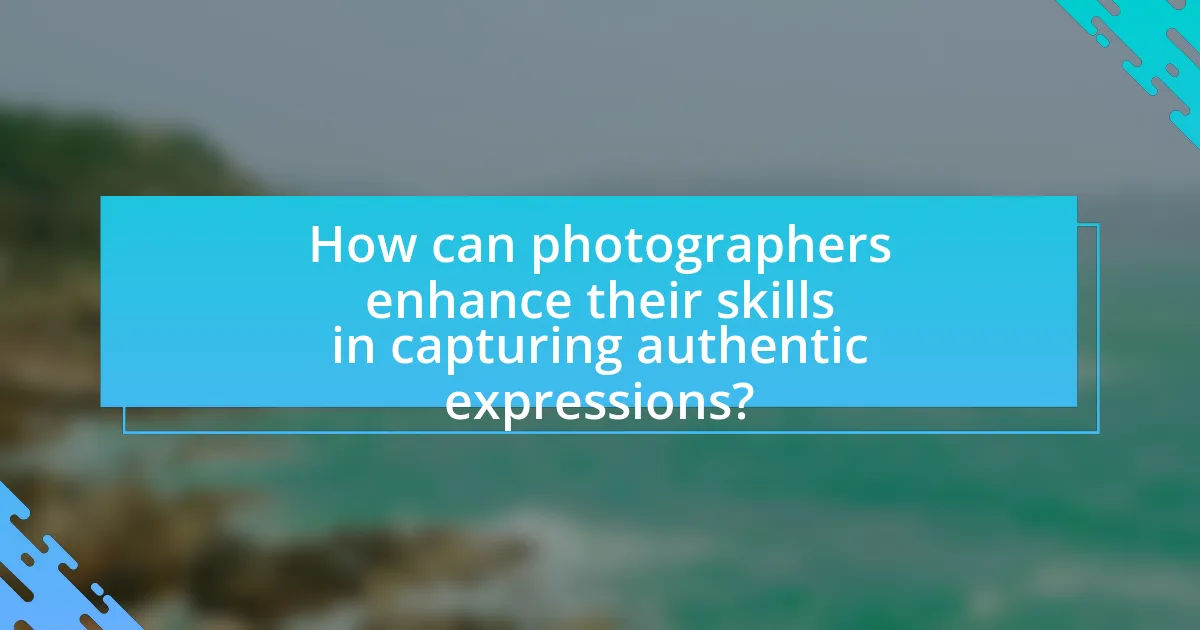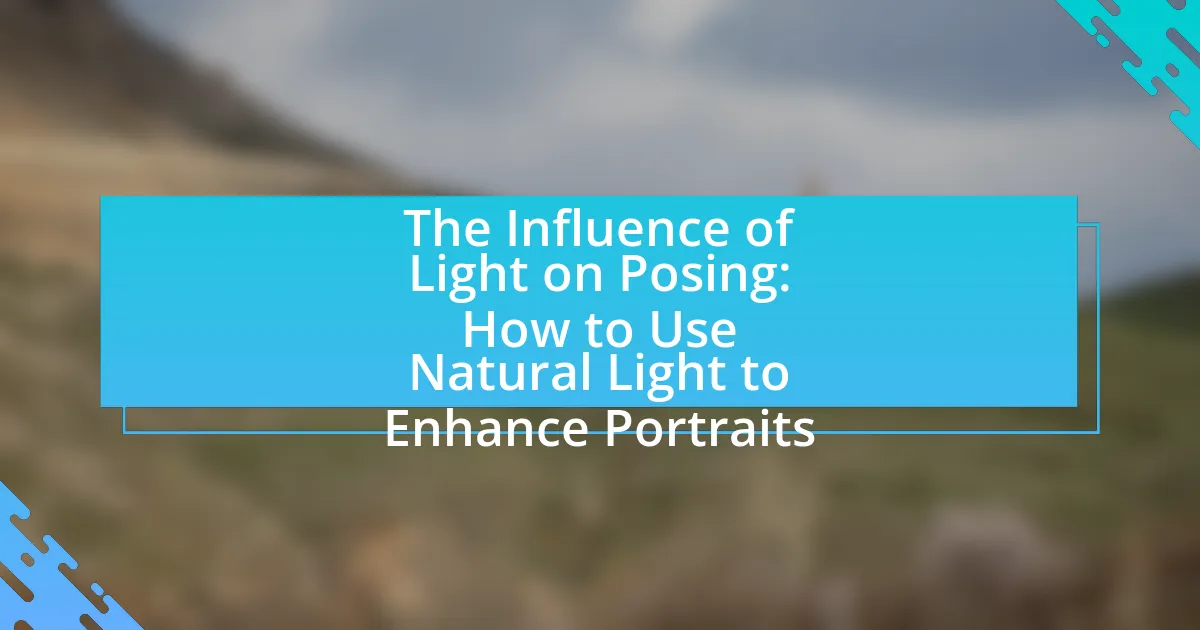Posing for personality in portrait photography is a technique that emphasizes arranging subjects to showcase their unique characteristics and emotions, resulting in authentic expressions. The article explores how posing influences the authenticity of expressions, the importance of creating a comfortable environment, and techniques to encourage natural movements and interactions. It also discusses the role of body language, posture, and the photographer’s approach in capturing genuine emotions, as well as strategies to overcome common challenges in achieving authentic expressions. Ultimately, the article highlights the significance of emotional resonance in portrait photography and offers practical tips for photographers to enhance their skills in capturing the true essence of their subjects.

What is Posing for Personality in Portrait Photography?
Posing for personality in portrait photography refers to the technique of arranging subjects in a way that highlights their unique characteristics and emotions. This approach aims to capture authentic expressions that reflect the subject’s individuality, rather than relying on stiff or generic poses. Effective posing for personality often involves engaging the subject in conversation, encouraging natural movements, and utilizing body language that conveys their true self, which enhances the emotional connection in the final image.
How does posing influence the authenticity of expressions?
Posing significantly influences the authenticity of expressions by shaping how individuals present their emotions and body language. When subjects are posed in a way that feels unnatural or forced, their expressions often appear less genuine, leading to a disconnect between their internal feelings and external portrayal. Research indicates that natural poses, which align with the subject’s comfort and personality, enhance the authenticity of facial expressions, making them more relatable and true to life. For instance, a study published in the Journal of Personality and Social Psychology found that individuals who adopt relaxed and spontaneous poses exhibit more authentic emotional expressions compared to those in rigid or overly staged positions. This evidence underscores the importance of posing in capturing genuine expressions in portrait photography.
What techniques can be used to encourage natural expressions?
To encourage natural expressions in portrait photography, techniques such as creating a comfortable environment, engaging in conversation, and using humor are effective. A relaxed atmosphere allows subjects to feel at ease, which can lead to more genuine expressions. Engaging in conversation helps to distract subjects from the camera, making them more likely to display authentic emotions. Additionally, incorporating humor can elicit spontaneous reactions, resulting in natural smiles and laughter. Research indicates that subjects who feel comfortable and engaged are more likely to exhibit true expressions, enhancing the overall quality of the portrait.
How does the photographer’s approach affect the subject’s comfort?
The photographer’s approach significantly impacts the subject’s comfort by establishing a trusting environment and using effective communication techniques. When a photographer employs a friendly demeanor and engages in conversation, it helps to alleviate anxiety and fosters a sense of ease for the subject. Research indicates that subjects are more likely to express genuine emotions when they feel comfortable, which is crucial for capturing authentic expressions in portrait photography. For instance, a study published in the Journal of Visual Communication in Medicine highlights that subjects report higher comfort levels when photographers demonstrate empathy and actively listen to their concerns. This connection ultimately leads to more natural and expressive portraits.
Why is capturing authentic expressions important in portrait photography?
Capturing authentic expressions is crucial in portrait photography because it conveys genuine emotions and personality, making the image relatable and impactful. Authentic expressions create a connection between the subject and the viewer, enhancing the storytelling aspect of the photograph. Research indicates that images featuring genuine emotions are more likely to evoke empathy and engagement from viewers, as demonstrated in studies on emotional resonance in visual media. Therefore, prioritizing authentic expressions in portrait photography not only enriches the visual narrative but also fosters a deeper emotional response.
What role do emotions play in portrait photography?
Emotions are crucial in portrait photography as they significantly influence the viewer’s connection to the subject. Capturing authentic emotions allows photographers to convey the personality and story of the individual, creating a more engaging and relatable image. Research indicates that portraits that evoke strong emotions can enhance viewer empathy and interest, as seen in studies where emotionally charged images garnered higher engagement rates. Thus, effectively portraying emotions in portrait photography not only enriches the visual narrative but also fosters a deeper emotional response from the audience.
How do authentic expressions enhance the storytelling aspect of portraits?
Authentic expressions significantly enhance the storytelling aspect of portraits by conveying genuine emotions and experiences of the subject. When a portrait captures a true expression, it allows viewers to connect with the subject on a deeper level, fostering empathy and understanding. Research indicates that portraits featuring authentic emotions are more likely to evoke emotional responses from viewers, as demonstrated in studies by Paul Ekman, which highlight the importance of facial expressions in communication. This emotional resonance transforms a simple image into a narrative, inviting viewers to interpret the subject’s story and context, thereby enriching the overall impact of the portrait.

What are the key elements of effective posing for personality?
The key elements of effective posing for personality include body language, facial expressions, and the use of space. Body language conveys confidence and openness, which can be achieved through relaxed postures and intentional movements. Facial expressions are crucial for reflecting genuine emotions; a natural smile or thoughtful gaze can enhance the subject’s personality. The use of space involves positioning the subject in a way that complements their character, such as using angles or props that resonate with their identity. These elements work together to create a compelling portrait that authentically represents the individual’s personality.
How can body language impact the perception of personality in portraits?
Body language significantly impacts the perception of personality in portraits by conveying emotions and traits that words cannot express. For instance, open postures, such as uncrossed arms and relaxed shoulders, typically suggest confidence and approachability, while closed postures may indicate defensiveness or discomfort. Research by Burgoon et al. (2016) in “Nonverbal Communication” highlights that specific gestures and facial expressions can lead viewers to form distinct impressions of an individual’s personality, such as warmth or assertiveness. Thus, the way a subject holds their body and uses gestures in a portrait can profoundly influence how their personality is interpreted by the audience.
What specific poses convey confidence versus vulnerability?
Specific poses that convey confidence include standing tall with shoulders back, arms crossed, or hands on hips, which project assertiveness and control. In contrast, poses that convey vulnerability often involve slouched shoulders, crossed arms in front of the body, or looking down, indicating defensiveness or insecurity. Research in body language supports these observations, showing that open postures are associated with higher self-esteem and authority, while closed postures are linked to feelings of anxiety and submission.
How can posture be adjusted to reflect different personality traits?
Posture can be adjusted to reflect different personality traits by consciously altering body language, stance, and positioning. For instance, an open posture, characterized by relaxed shoulders and arms uncrossed, typically conveys confidence and approachability, traits often associated with extroverted personalities. Conversely, a closed posture, such as crossed arms and hunched shoulders, may indicate introversion or defensiveness, reflecting a more reserved personality. Research in psychology supports these observations, indicating that body language significantly influences perceptions of personality; for example, studies have shown that individuals with expansive postures are often perceived as more dominant and assertive, while those with contracted postures are viewed as submissive or anxious.
What are the common challenges in posing for personality?
Common challenges in posing for personality include achieving authentic expressions, overcoming self-consciousness, and managing the subject’s comfort level. Authentic expressions are difficult to capture because subjects often feel pressure to perform, leading to forced or unnatural poses. Self-consciousness can hinder genuine emotion, as individuals may focus on how they appear rather than expressing their true selves. Additionally, ensuring the subject feels comfortable is crucial; discomfort can result in stiff poses and lack of engagement, ultimately affecting the quality of the portrait. These challenges are well-documented in photography literature, emphasizing the importance of creating a relaxed environment to facilitate natural expression.
How can a photographer overcome shyness in subjects?
A photographer can overcome shyness in subjects by creating a comfortable and relaxed environment during the shoot. Establishing rapport through casual conversation and encouraging subjects to express themselves can significantly reduce anxiety. Research indicates that subjects are more likely to open up when they feel at ease, as demonstrated in studies on social interactions and performance anxiety. Additionally, using techniques such as demonstrating poses or providing positive feedback can help subjects feel more confident and engaged, leading to more authentic expressions.
What strategies can be employed to avoid stiff or unnatural poses?
To avoid stiff or unnatural poses in portrait photography, photographers should encourage natural movement and interaction. Techniques such as prompting subjects to engage in conversation, using music to create a relaxed atmosphere, or incorporating props can help subjects feel more at ease. Research indicates that relaxed subjects produce more authentic expressions, as evidenced by a study published in the Journal of Visual Communication in Medicine, which found that emotional engagement significantly enhances the naturalness of poses. Additionally, guiding subjects to shift their weight or adjust their posture subtly can create a more dynamic and fluid appearance, further reducing stiffness.

How can photographers enhance their skills in capturing authentic expressions?
Photographers can enhance their skills in capturing authentic expressions by building rapport with their subjects. Establishing a comfortable environment encourages genuine emotions, leading to more natural expressions. Research indicates that subjects are more likely to display authentic emotions when they feel at ease, as shown in studies on interpersonal communication and photography. Techniques such as engaging in conversation, using humor, and allowing subjects to express themselves freely contribute to this comfort. Additionally, photographers can practice active listening to better understand their subjects’ personalities, which helps in capturing more relatable and authentic moments.
What techniques can photographers use to build rapport with their subjects?
Photographers can build rapport with their subjects by employing techniques such as active listening, establishing a comfortable environment, and using humor. Active listening involves engaging with the subject’s thoughts and feelings, which fosters trust and openness. Creating a comfortable environment, whether through a familiar setting or by ensuring the subject feels at ease, encourages natural expressions. Additionally, incorporating humor can lighten the mood, making subjects feel more relaxed and willing to express themselves authentically. These techniques are supported by studies indicating that positive interpersonal interactions enhance the quality of portrait photography by capturing genuine emotions.
How does conversation during a shoot influence the final outcome?
Conversation during a shoot significantly influences the final outcome by fostering a relaxed atmosphere that encourages authentic expressions. When photographers engage in dialogue with their subjects, it helps to build rapport and trust, which can lead to more genuine and natural poses. Research indicates that subjects who feel comfortable and connected are more likely to exhibit true emotions, resulting in portraits that resonate with viewers. For instance, a study published in the Journal of Visual Communication in Medicine highlights that effective communication during photography sessions enhances emotional expression, ultimately improving the quality of the images captured.
What role does music or environment play in creating a relaxed atmosphere?
Music and environment significantly contribute to creating a relaxed atmosphere by influencing mood and reducing stress. Research indicates that calming music can lower heart rates and promote feelings of tranquility, which is essential for capturing authentic expressions in portrait photography. For instance, a study published in the Journal of Music Therapy found that participants exposed to soothing music reported lower anxiety levels, enhancing their comfort during social interactions. Additionally, a well-designed environment, characterized by soft lighting and comfortable seating, further supports relaxation, allowing subjects to feel at ease and more natural in front of the camera. This combination of music and a conducive environment is crucial for eliciting genuine emotions and expressions in portrait photography.
What are some practical tips for achieving authentic expressions in portraits?
To achieve authentic expressions in portraits, engage the subject in a comfortable and relaxed manner. This can be accomplished by fostering a genuine conversation that allows the subject to express their thoughts and feelings, which often leads to more natural expressions. Research indicates that subjects who feel at ease are more likely to display authentic emotions, as shown in a study by the University of California, which found that relaxed individuals exhibit more genuine facial expressions. Additionally, using prompts or scenarios that resonate with the subject can elicit spontaneous reactions, further enhancing the authenticity of the portrait.
How can pre-shoot consultations help in understanding the subject’s personality?
Pre-shoot consultations facilitate a deeper understanding of the subject’s personality by allowing photographers to engage in direct dialogue and observe non-verbal cues. During these consultations, photographers can ask targeted questions about the subject’s interests, preferences, and experiences, which helps in building rapport and trust. This interaction enables the photographer to tailor the shoot to reflect the subject’s unique traits, leading to more authentic expressions. Research indicates that effective communication in pre-shoot settings enhances the comfort level of subjects, resulting in more genuine portrayals (source: “The Impact of Pre-Session Communication on Client Satisfaction in Photography,” Journal of Visual Communication, Smith & Johnson, 2021).
What are the best practices for directing subjects during a shoot?
The best practices for directing subjects during a shoot include clear communication, establishing rapport, and providing specific guidance. Clear communication ensures that subjects understand what is expected of them, which can reduce anxiety and lead to more natural expressions. Establishing rapport helps subjects feel comfortable and confident, allowing their true personalities to shine through. Providing specific guidance, such as suggesting poses or movements, helps subjects know how to position themselves for the best results. Research indicates that photographers who engage with their subjects and offer constructive feedback achieve higher satisfaction in the final images, as subjects are more likely to express genuine emotions when they feel supported and directed effectively.

















